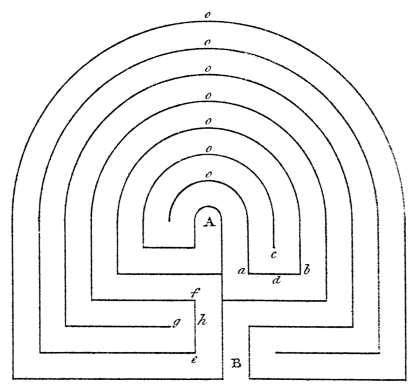
Extract from Peter Roberts, The Cambrian Popular Antiquities, pp. 212–213 + plate (1815)
{212}
see the drawing.
This is the name given to a delineation of the plan of a labyrinth, which is sometimes cut out in the turf by shepherd boys, whilst they are tending their flocks on the mountains of Wales; and sometimes drawn, and presented as a puzzle by school-boys, to exercise the ingenuity of their school-fellows, either in finding the way to the citadel A, or in drawing the plan. The tradition which accompanies the plan is, that the city of Troy was defended by seven walls represented by the seven exterior lines, and the entrance from B made so intricate for its greater security, as the enemy is supposed to have been under the necessity of going through all the winding interval of the walls before he could arrive {213} at the citadel. In Welsh, the name given to this plan is Caer Droea, or The City of Troy; and the name is a sufficient evidence, that a tradition respecting Troy must have been very popular in Wales, though I suspect, that Caer Droea is a corruption of Caer Droeau, the city of turnings, that is, of the Labyrinth; and even so the evidence of the popular tradition, as to Troy, is not lessened, but rather the reverse, because, that in the corruption of words, those which are most familiar are always the substitutes of words whose significations are less so.

In the plan itself, there is considerable ingenuity. As usually drawn, the points a, b, and e, f, are usually connected by a line, as in the scheme. This line, however, should be omitted, and the lines c and g, being extended to d and h, it would be properly a labyrinth, which, at present, it is not, as there are no means of losing the way into the citadel; the supposed way continuing regularly through all its windings unbroken, which could scarcely have been the design of the inventor.